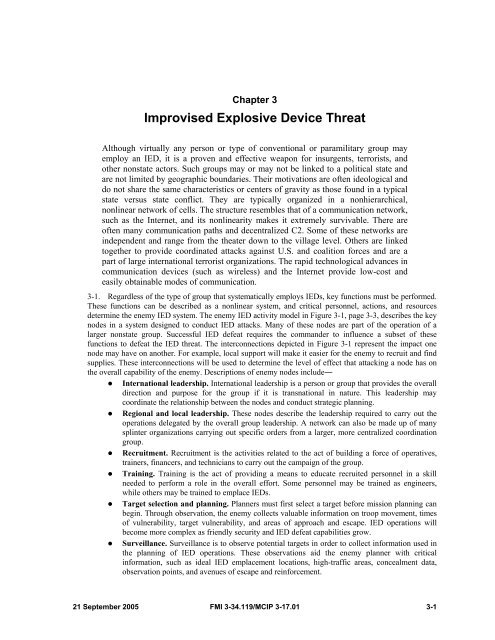FMI 3-34.119 - Soldier Support Institute - U.S. Army
FMI 3-34.119 - Soldier Support Institute - U.S. Army
FMI 3-34.119 - Soldier Support Institute - U.S. Army
Create successful ePaper yourself
Turn your PDF publications into a flip-book with our unique Google optimized e-Paper software.
Chapter 3Improvised Explosive Device ThreatAlthough virtually any person or type of conventional or paramilitary group mayemploy an IED, it is a proven and effective weapon for insurgents, terrorists, andother nonstate actors. Such groups may or may not be linked to a political state andare not limited by geographic boundaries. Their motivations are often ideological anddo not share the same characteristics or centers of gravity as those found in a typicalstate versus state conflict. They are typically organized in a nonhierarchical,nonlinear network of cells. The structure resembles that of a communication network,such as the Internet, and its nonlinearity makes it extremely survivable. There areoften many communication paths and decentralized C2. Some of these networks areindependent and range from the theater down to the village level. Others are linkedtogether to provide coordinated attacks against U.S. and coalition forces and are apart of large international terrorist organizations. The rapid technological advances incommunication devices (such as wireless) and the Internet provide low-cost andeasily obtainable modes of communication.3-1. Regardless of the type of group that systematically employs IEDs, key functions must be performed.These functions can be described as a nonlinear system, and critical personnel, actions, and resourcesdetermine the enemy IED system. The enemy IED activity model in Figure 3-1, page 3-3, describes the keynodes in a system designed to conduct IED attacks. Many of these nodes are part of the operation of alarger nonstate group. Successful IED defeat requires the commander to influence a subset of thesefunctions to defeat the IED threat. The interconnections depicted in Figure 3-1 represent the impact onenode may have on another. For example, local support will make it easier for the enemy to recruit and findsupplies. These interconnections will be used to determine the level of effect that attacking a node has onthe overall capability of the enemy. Descriptions of enemy nodes include―• International leadership. International leadership is a person or group that provides the overalldirection and purpose for the group if it is transnational in nature. This leadership maycoordinate the relationship between the nodes and conduct strategic planning.• Regional and local leadership. These nodes describe the leadership required to carry out theoperations delegated by the overall group leadership. A network can also be made up of manysplinter organizations carrying out specific orders from a larger, more centralized coordinationgroup.• Recruitment. Recruitment is the activities related to the act of building a force of operatives,trainers, financers, and technicians to carry out the campaign of the group.• Training. Training is the act of providing a means to educate recruited personnel in a skillneeded to perform a role in the overall effort. Some personnel may be trained as engineers,while others may be trained to emplace IEDs.• Target selection and planning. Planners must first select a target before mission planning canbegin. Through observation, the enemy collects valuable information on troop movement, timesof vulnerability, target vulnerability, and areas of approach and escape. IED operations willbecome more complex as friendly security and IED defeat capabilities grow.• Surveillance. Surveillance is to observe potential targets in order to collect information used inthe planning of IED operations. These observations aid the enemy planner with criticalinformation, such as ideal IED emplacement locations, high-traffic areas, concealment data,observation points, and avenues of escape and reinforcement.21 September 2005 <strong>FMI</strong> 3-<strong>34.119</strong>/MCIP 3-17.01 3-1
















